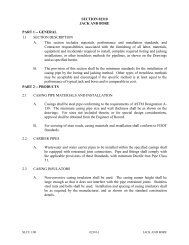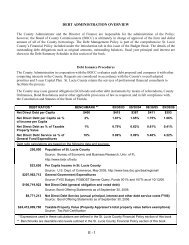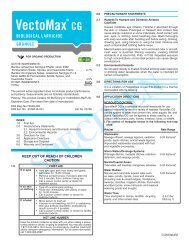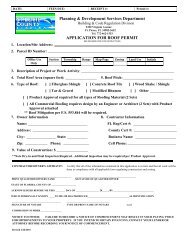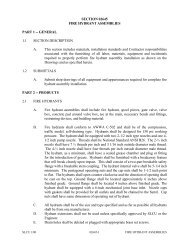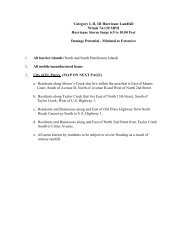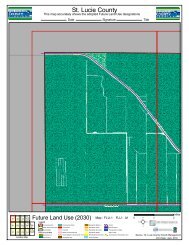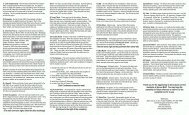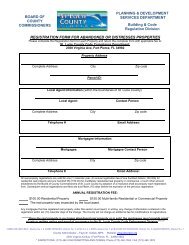TAC Meeting Minutes - St. Lucie County
TAC Meeting Minutes - St. Lucie County
TAC Meeting Minutes - St. Lucie County
You also want an ePaper? Increase the reach of your titles
YUMPU automatically turns print PDFs into web optimized ePapers that Google loves.
Technical Advisory <strong>Meeting</strong>Master Plan Update<strong>St</strong>. <strong>Lucie</strong> <strong>County</strong>International Airport<strong>Meeting</strong> <strong>Minutes</strong>THELPAGROUPTRANSPORTATION CONSULTANTS<strong>Meeting</strong> Date:October 14, 2009 @ 6:00 pm ESTSubject: Technical Advisory Committee (<strong>TAC</strong>) <strong>Meeting</strong>/Workshop #4Attendees:Author:Attached Sign-In SheetTricia FantinatoThese meeting minutes provide a summary of the information and comments provided during the TechnicalAdvisory Committee meeting. Please note that Mr. Philip Jufko, Director of Planning, The LPA GroupIncorporated acted as moderator during this process. Comments or questions provided by him to stir discussionare designated as “Moderator Question or Comment”. Questions from <strong>TAC</strong> Members will be designated as such.Comments and opinions from <strong>TAC</strong> members are denoted as “Commentator stated”. Any questions, opinions orcomments from the Public are also designated as such. This meeting was held in a workshop type of environmentto encourage discussion amongst the <strong>TAC</strong> Members as well as members of the public. We have attempted tocapture this dialogue in these meeting minutes. Note: The <strong>TAC</strong> meeting was taped, and can be made availableupon request.Copies of the meeting presentation and agenda are provided on the project website (www.stlucieco.org/airport).SHOULD YOU DISAGREE WITH THE INFORMATION IN THIS RECORD, PLEASE ADVISE IMMEDIATELY(TFantinato@lpagroup.com). Thank you.I. Airport TourPrior to the Technical Advisory <strong>Meeting</strong>, 05:00 pm EST, airport management organized a tour of theairport facilities to familiarize members with existing airport facilities and available land/leaseholdsfor development.II.IntroductionFollowing the tour, members of the <strong>TAC</strong> joined airport tenants and some members of the generalpublic in the Airport Administration Building to evaluate airport requirements and determine thelong-range direction of airport development. Ms. Diana Lewis (D. Lewis), AAE, Airport Director,welcomed everyone to the meeting and thanked them for participating in the Master Plan process.She also reminded the <strong>TAC</strong> members that they are still bound by Sunshine Rules and that their activeparticipation in this process is encouraged especially during the next few meetings.D. Lewis also conveyed the Board of <strong>County</strong> Commissioners policy that members of the <strong>TAC</strong>,especially those nominated to represent the five commissioners, who miss more than two (2)meetings, may be replaced. The Board is very interested in the recommendations of the <strong>TAC</strong> in thisprocess so participation is important.Members of the public are also encouraged to provide written comments either at the meeting viacomment cards or through the project website.November 2009 Page | 1 DRAFT
Technical Advisory <strong>Meeting</strong>Master Plan Update<strong>St</strong>. <strong>Lucie</strong> <strong>County</strong>International Airport<strong>Meeting</strong> <strong>Minutes</strong>THELPAGROUPTRANSPORTATION CONSULTANTSD. Lewis than introduced Todd Cox, Airport Manager, and members of the master plan team, andturned over the meeting to Mr. Robert Greene, Chairman of the Technical Advisory Committee to callthe meeting to order.III.Technical Advisory Committee WorkshopMr. Robert Greene was elected during the previous <strong>TAC</strong> <strong>Meeting</strong> (June 30, 2009) as the chairpersonof the <strong>TAC</strong> committee. Mr. Greene called the meeting to order, and then turned it back over to thepresentation team for confirmation of the June 30 th meeting minutes and a project status report.No comments were received and the meeting minutes were approved. Mr. Philip Jufko (Moderator)explained the purpose of the meeting. He emphasized that the alternatives to be presented werebased upon <strong>TAC</strong> input received from the June 30 th Workshop. In order to move forward, it isnecessary to determine, during this meeting, the long-term role of <strong>St</strong>. <strong>Lucie</strong> <strong>County</strong> Airport as well asthe type of development necessary to accommodate that role.Moderator Comments: the Alternatives Chapter will include the recommendations and commentsreceived during the <strong>TAC</strong> and Public <strong>Meeting</strong>s. This information is to be presented to the Board of<strong>County</strong> Commissioners at a Board <strong>Meeting</strong>. Upon the BOCC’s approval, Chapter 5 will be finalized.Moderator Comment: At the request of the BOCC, LPA had individual meetings with each of theBoard members. They were all very interested in the process and want to make sure that theirrepresentatives are participating because they are looking to the <strong>TAC</strong> to provide input to them withregard to the alternatives as well as provide a recommendation for future aviation development.Today, at the request of the BOCC, LPA presented an abbreviated version of master plandevelopment to the <strong>St</strong>. <strong>Lucie</strong> <strong>County</strong> Tourism Development Council. The purpose of which was todemonstrate how the master plan can relate to tourism in <strong>St</strong>. <strong>Lucie</strong> <strong>County</strong>.III.Airport RolesModerator Comment: In order to accurately determine airport requirements for the twenty yearplanning period, a consensus must be obtained from the <strong>TAC</strong> on the long-term airport role.Currently the airport serves general aviation operations only, which include flight training, corporatetraffic, emergency services, fractional ownership, and on-demand air taxi/air charter operations.However, at the request of the BOCC and based upon interest by the Bahamas Tourism Board,generalized facility and operational requirements needed for FPR to support commercial service wasrequested.Moderator Comment: Based upon this request, alternative scenarios were developed based uponthe following three (3) roles: General Aviation:o Airport’s current roleo What needs to be addressed in the next five to 10 year period Limited Commercial Service:November 2009 Page | 2 DRAFT
Technical Advisory <strong>Meeting</strong>Master Plan Update<strong>St</strong>. <strong>Lucie</strong> <strong>County</strong>International Airport<strong>Meeting</strong> <strong>Minutes</strong>THELPAGROUPTRANSPORTATION CONSULTANTSo Potential Bahamasair opportunityo What is the opportunities to bring limited commercial service to FPRo How quickly can FPR implement the requirements needed to support such acommuter type service (i.e. Part 139 Certification)Air Carrier Commercial Serviceo Anticipate to occur well beyond 20-year planning periodo Primarily evaluated to determine highest and best land use and coordinatedevelopment with countywide long-range planning.Moderator Questions: Does the <strong>TAC</strong> still support GA and some limited commercial development ifdemand warranted at FPR? Also does the <strong>TAC</strong> still want show the reservation of on-airport propertyto support expanded service beyond the 20-year planning period?Moderator Questions: Are there any other roles that need to be considered? Is the planning teamgoing in the right direction by evaluating the potential for limited commercial service within thetwenty-year planning period?Moderator Comment: A commercial forecast was not developed as part of this master plan, so atthis time there is no justification for commercial development merely potential.<strong>TAC</strong> Question: Why wasn’t a commercial forecast developed?Team Answer: At this time, there is no historical or existing demand for such service at FPR.Therefore an accurate forecast of commercial demand cannot be determined at this time. However,the potential for commercial service was considered to determine highest and best land use ofairport property.<strong>TAC</strong> Question: To what extent do projections play into these roles?Team Answer: Available projections drive some of the requirements and impact the size and type of facilitiesrequired. However, for commercial service, the aircraft, FAA Part 139, US Customs and TSA requirementsare driving the recommended improvements outlined in two of the alternative developmentscenarios (Alternatives 2A, 2B and 3). For Alternative 3, Air Carrier Service, recommendations were based upon similarly sized airportsthat support air carrier (legacy) commercial service as well as the type of aircraft, FAA and TSAregulations. Recommendations and requirements denoted for this alternative were merely usedto obtain a land use envelope in an effort to reserve property for the potential of futurecommercial development.One Commentator stated ‘When it comes to projections, a lack of facility does not preclude futuredevelopment. We do this on roadway development all the time.’Team Comment: In this case, accurate projections could not be developed. Therefore, typicalcorporate and commercial aircraft were used as a benchmark for development. However,November 2009 Page | 3 DRAFT
Technical Advisory <strong>Meeting</strong>Master Plan Update<strong>St</strong>. <strong>Lucie</strong> <strong>County</strong>International Airport<strong>Meeting</strong> <strong>Minutes</strong>THELPAGROUPTRANSPORTATION CONSULTANTSprojections drive the justification and project funding. Commercial development can be shown but isnot likely justifiable in the near term (next 5 years).Moderator Request/Verification: Does the <strong>TAC</strong> want this master plan to address the immediateairport needs associated with its role as a general aviation airport? Does the <strong>TAC</strong> also want themaster plan to identify minimum requirements needed to accommodate commercial service ifwarranted?At least three commentators stated ‘Even though there is no demonstrated demand at this time, itshould still be included so it can be reevaluated in later master plans.’IV.Review of <strong>TAC</strong> RecommendationsA summary of group recommendations provided in the June 30 th meeting provided the basis for theAlternative Development Options. Some of the issues that required evaluation included: Impacts of Power Lines Existing and Future Aircraft Fleet Mix and Airfield Requirements Evaluate runway extension options (east and west) Extension of Runway 14-32 US Customs and Passenger Terminal Requirements Surface transportation network, multimodal facilities, aviation and industrial development, etc.One Commentator Requested ‘Please evaluate as part of the master plan update how FPR canbecome an official US Customs Port of Entry airport so that the hours of operation can be extendedfrom the current schedule of 10:00 AM to 6:00 PM. US Customs’ limited hours of operations impactsour businesses (Volo Aviation and Key Air Aviation) because it makes the airport less attractive topotential users. If the airport became an official Port of Entry, it would likely (in my opinion) expandservices provided and hours of operations and support new business development.’Team Response: FPR is currently a landing rights airport, and US Customs also serves the Port of Ft.Pierce. According to Customs, the hours were cut because there wasn’t sufficient demand at certaintimes of the day to warrant the staff. If demand increases, US Customs will reevaluate theiroperations at FPR. However, the Team will determine what may be required for FPR to become anofficial Port of Entry.V. Facility Requirements Extension of Runway 14-32: The Team presented two options for the extension of Runway 14-32:extend to 5,500 feet or 5,700 feet. The <strong>TAC</strong>, during the June 30 th Workshop, agreed that thelonger option allowed for aircraft to remain outside the Object Free Area of Runway 10R-28L. Anextension of Runway 14-32 has been included in the last two previous master plan updates.Although it may not be considered a high priority, an extension is still warranted.Moderator Question/Verification: Do you the members of the <strong>TAC</strong> still agree with the longerextension of Runway 14-32?November 2009 Page | 4 DRAFT
Technical Advisory <strong>Meeting</strong>Master Plan Update<strong>St</strong>. <strong>Lucie</strong> <strong>County</strong>International Airport<strong>Meeting</strong> <strong>Minutes</strong>THELPAGROUPTRANSPORTATION CONSULTANTSAlthough not put to a vote, the <strong>TAC</strong> members attending either provided a verbal or physicalresponse (nod of the head) that they agreed with the extension of Runway 14-32. Note: supportof this option is also shown in the June 30 th published and approved meeting minutes.Pavement <strong>St</strong>rength: Pavement strength requirements were also identified as part of the facilityrequirements. Demand at this time does not support a strengthening of Runway 10R-28L, but itmay be warranted in the future (next 6 to 10 years). However, an environmental assessmentmust be conducted prior to preliminary design. NextGen Opportunities: Dr. Dave Byers (D. Byers) presented how NextGen can improveairspace, airport and aircraft operations by:o Providing a virtual tower to assist pilots when landing at an airport when the tower is closedduring poor weather.o Can be used in support of voluntary noise abatement procedures by clarifying requirementsand thereby limiting the aircraft “scatter pattern”.o Improve airspace efficiency allowing aircraft to fly direct routes rather than point to pointand utilize controlled descent procedures rather than step-down descent procedures. Thiswill improve not only noise but air quality.o Decrease runway incursions and provide ATC greater visibility of airfield “hot spots”.o Allows aircraft and ground vehicles to be monitored even in low visibility conditions.o Could decrease the area needed to support approach and departure procedures therebyfreeing up real estate for revenue use.o Corporate and commercial aircraft are currently being equipped with this technology, andthis technology is being implemented at a number of commercial airports. The south Floridaregion is also one of the first areas to be equipped with the ground based system (antennasare located at Hobe Sound and Sebastian Airport). The region is being used as test bed forfuture quantifiable development.<strong>TAC</strong> Question: How accurate is vertical GPS?Team Response: The GPS is accurate enough for Air Traffic Control.One Commentator <strong>St</strong>ated: ‘It looks like NextGen can be used for voluntary noise restrictions.’Team Response: Yes, FAA is working on this now by allowing controlled descent rather than a stepdown descent which drastically decreases noise on approach. Further, GPS limits the “scatter”pattern typically caused by pilot interpretation of noise abatement procedures, therefore decreasingnoise impacts to residential areas adjacent to an airport. Aircraft follow the “yellow brick road” in thesky.<strong>TAC</strong> Question: Is this something that can be incorporated into the master plan update?Team Response: Yes, a recommendation can be added to the master plan that as new technologybecomes available that operating procedures be implemented to support future development.<strong>TAC</strong> Question: As the technology becomes more widely available, would the FAA limit fundingavailable to airports not equipped with these facilities?November 2009 Page | 5 DRAFT
Technical Advisory <strong>Meeting</strong>Master Plan Update<strong>St</strong>. <strong>Lucie</strong> <strong>County</strong>International Airport<strong>Meeting</strong> <strong>Minutes</strong>THELPAGROUPTRANSPORTATION CONSULTANTSTeam Response: It is unlikely that FAA will limit funding. However, it is suggested that on the locallevel that the airport embrace this technology and incorporate procedures to improve operations atthe airport while limiting impacts to noise sensitive areas.<strong>TAC</strong> Question: What type of equipment is needed in support of this technology?Team Response: No additional equipment is required. To implement, procedures should becoordinated with local policies and the FAA to develop operational procedures to address the airportand community’s needs.<strong>TAC</strong> Recommendations: Look at NextGen to address noise; Want <strong>St</strong>. <strong>Lucie</strong> to take the lead with regard to NextGen:o Implement into local policy, ando Current airport procedures<strong>TAC</strong> Question: Are they eliminating the hub and spoke structure?Team Response: Yes and no. At hub airports, it is anticipated to help. However, the biggest problemis not airspace or operational procedures but lack of gates and limited parking. This has been thebiggest cause of delays within the airspace system.Draft Noise Contours: Preliminary 2008/09 Noise Contours show that when compared to the2005 Part 150 Forecast and with the construction of the new training runway, the contoursremain on airport property. Additional noise contours based upon the <strong>TAC</strong>’s recommendeddevelopment and forecast fleet mix will be run as part of the refined airport developmentanalysis.<strong>TAC</strong> Question: Is DNL the same as LdN?Team Response: Yes<strong>TAC</strong> Question: If commercial service were to start, say with Bahamasair, would that negativelyimpact <strong>St</strong>. <strong>Lucie</strong> Village?Team Response: No, it is anticipated that Bahamasair would use the DH-8 Q300 which is a turbopropaircraft which is designed to operate in populated areas and its operational noise levels are veryquiet.<strong>TAC</strong> Question: What about the aircraft shown in Alternative 2B (CRJ-900)? Would this impact the <strong>St</strong>.<strong>Lucie</strong> Village?Team Response: The CRJ-900 used for this alternative is based upon the newest model (CRJ-900ER(NextGen). Again like the DH-8 Q300, it is a <strong>St</strong>age IV aircraft under Federal Aviation Regulations andwas designed to be more environmentally friendly than its predecessors (lower noise and particulateNovember 2009 Page | 6 DRAFT
Technical Advisory <strong>Meeting</strong>Master Plan Update<strong>St</strong>. <strong>Lucie</strong> <strong>County</strong>International Airport<strong>Meeting</strong> <strong>Minutes</strong>THELPAGROUPTRANSPORTATION CONSULTANTSemissions). Further both aircraft have a steeper climb gradient allowing for aircraft to reach altitudemuch quicker thereby decreasing noise impacts to properties adjacent to the airport.Two members of the public stated that ‘The new Training Runway (10L-28R) is not improving aircraftnoise over <strong>St</strong>. <strong>Lucie</strong> Village.’One Commentator stated that ‘he had also heard from people in the Village, although he waspersonally not impacted, that the training runway had not improved aircraft noise’.Mr. Bob Greene, <strong>TAC</strong> Chairperson, stated that the Training Runway has several drawbacks includinglack of connectivity to the main airfield, taxi back procedures and no precision approach pathindicator lights.D. Lewis stated that Mr. Jerry Groendyke, FAA Air Traffic Control Manager, should address the use ofthe new training runway.Mr. Groendyke’s Response: Runway 10L-28R is being used more than originally anticipated. It is being used for all full stoptaxi back and touch and go procedures including those from transient (visiting) aircraft. All runways are being used by training aircraft based upon operating conditions. However, whenpossible, ATC is directing operations to the Training Runway. <strong>St</strong>udents however are requesting to use Runway 10R-28L when the ATCT is still open in theevening because of the power lines and the lack of approach lighting. Further, instructors request that pilots on their first solo flight use Runway 10R-28L since theyare able to watch their students from the apron and because Runway 10R-28L is wider andlonger. Approximately 80 percent of training traffic is currently routed to Runway 10L-28R, so <strong>St</strong>. <strong>Lucie</strong>Village should see a significant decrease in noise impacts associated with training operations. He did say he was not aware of what happens after the tower closes.Public Question: Residents of <strong>St</strong>. <strong>Lucie</strong> Village saw an increase in traffic on October 14. Why?Mr. Groendyke’s Response: Today was a different situation since they had training aircraft usingRunway 14-32 because survey work was being done. Mr. Groendyke stated that the new runwayprovides greater separation of traffic between corporate and training activity, has reduced runwaycrossings by 50 percent, and reduced over flights of <strong>St</strong>. <strong>Lucie</strong> Village.D. Lewis also stated that the airport is tracking evening operations (when the ATC is closed), and hasseen that over 80 percent of traffic is using Runway 10L-28R (Training Runway), and this informationis available on the airport website.<strong>TAC</strong> Question: Does the website also have daytime operations?D. Lewis Response: No, we are currently only tracking operations when the air traffic control toweris closed.November 2009 Page | 7 DRAFT
Technical Advisory <strong>Meeting</strong>Master Plan Update<strong>St</strong>. <strong>Lucie</strong> <strong>County</strong>International Airport<strong>Meeting</strong> <strong>Minutes</strong>THELPAGROUPTRANSPORTATION CONSULTANTSVI.Preliminary AlternativesAs part of the preliminary development, development zones were created to identify priority zonesfor future on-airport development during and beyond the twenty-year planning period.Moderator Comments: The goal of this meeting is to determine which one of the alternative optionsor a hybrid of the three options reflects the <strong>TAC</strong>’s vision for long-term development at FPR. Some projects are phased throughout the planning process, such as fencing. The stormwater master plan update is in process; therefore the recommendations of the AirportMaster Plan Update will be incorporated into this document. Ultimate development is based upon the airport’s role, operational demand and criticalaircraft. To accommodate commercial service (FAR Part 139), the airport must meet therequirements outlined in FAR Part 139 for the type of service it is supporting (Class I, II, IIIand IV), TSA 1540/42, Airport Security Requirements, Aircraft Rescue and Fire FightingRequirements (AC 150/5210-6D) as well as a host of design requirements outlined in variousFederal Aviation Advisory Circulars. Airport requirements to support commercial service are also dependent upon the Part 121operator likely to use the airport. Some carriers (typically legacy) have stricter standards aspart of the operating certificate than even those outlined in the FAA Advisory Circulars andRegulations. Therefore, sometimes requirements and timing of development not exactly“black and white”. Thus, alternative development was based upon anticipated level of service and aircrafttypically used in support of that service.<strong>TAC</strong> Question: In evaluating long-term requirements, shouldn’t development be based upon aGulfstream 6 or a DH-9?Team Response: A future fleet mix was done as part of the forecasting and facility requirementsefforts. Aircraft can stay within a fleet up to 20 to 30 years with maintenance and modifications. Weused the newest and most advanced of each model in an effort to determine facility requirements.However, new technology is coming out all the time. So when there is demand for such facilities, ajustification must be done based upon the actual aircraft at that time.<strong>TAC</strong> Question: (Related to Noise) Since you can’t regulate or prevent certain aircraft operating at anairport, can you not provide some incentive in order to attract quieter aircraft?Team Response: Yes, it can be done but it would take a lot to implement. This has been used atsome airports through landing fees. However, how do you determine the marginal benefit, and theairport cannot discriminate against other operators.One Commentator stated (and was supported by another) that ‘The FBO’s do have incentives as partof their marketing plans in an effort to attract newer aircraft. They offer discounts in order topromote development. However, it is difficult (in my opinion) if not impossible to attract theseaircraft if the airport itself does not meet design standards required by that aircraft. In order tocontinue to grow and promote the airport, infrastructure must be in place to accommodate thisdemand.’November 2009 Page | 8 DRAFT
Technical Advisory <strong>Meeting</strong>Master Plan Update<strong>St</strong>. <strong>Lucie</strong> <strong>County</strong>International Airport<strong>Meeting</strong> <strong>Minutes</strong>THELPAGROUPTRANSPORTATION CONSULTANTSTeam Comment: This, however, is the “Catch-22” – FAA won’t support certain improvements untilyou show demonstrated demand (i.e. 500 annual operations in the next five years). However, someaircraft operators won’t use the airport because it doesn’t meet their operating requirements.<strong>TAC</strong> Question: What is the market area of Charlotte <strong>County</strong> Airport? How does it compare to <strong>St</strong>.<strong>Lucie</strong> <strong>County</strong>?Team Response: Charlotte <strong>County</strong> Airport’s market area includes Ft. Myers, Sarasota and SouthTampa. The users of Charlotte <strong>County</strong> Airport are price sensitive and don’t need to get to a specificcity rather they are looking to get to a certain region and then they will use other transportation toget to their ultimate destinations. This is why Allegiant has been so successful.One Commentator stated ‘Skybus was at <strong>St</strong>. Augustine Airport but went out of business.’Team Response: Skybus didn’t go out of business because of lack of demand rather it was associatedwith the credit crisis and credit card hold backs. Skybus proved that people would fly to a regionrather than a specific city if the fares were low enough.<strong>TAC</strong> Question: What does Allegiant Air Fly?Team Response: Allegiant flies DC9 Aircraft which are typically 90 percent full. However, as part oftheir model, if they can’t achieve this load factor at an airport, they will pull out as they have recentlydone at Columbia Metro in South Carolina.<strong>TAC</strong> Question: What is required to support commercial service at <strong>St</strong>. <strong>Lucie</strong>?Team Response: With the exception of the Terminal and TSA requirements, the airport has a lot ofthe physical facilities necessary to support some level of commercial service. However, some aircarriers as part of their operating certificate may have certain physical requirements with regard towhere they operate. We won’t know this until you speak to the operator.The Moderator described Alternatives 2A and 2B, Limited Commercial Service, and stated that eachalternative is based upon different critical aircraft. Alternative 2A is based upon the requirements ofthe Gulfstream 550 (General Aviation Critical Aircraft) and DH-8 Q300 (Commercial Critical Aircraft).Alternative 2B is based upon the CRJ-900ER (NextGen).The Moderator presented two draft commercial options based upon a rehabilitation of the existingAirport Administration Building. However, the Architectural Team associated with this developmentstill needed to speak with TSA regarding their commercial requirements.D. Lewis mentioned that the Architectural Team was looking at coordinating development with USCustoms and possibly connecting the two buildings.The Moderator stated that one of the biggest differences between Alternative 2A and 2B is that in2B, the FPL Power Transmission Lines will need to be relocated to allow for lower approach minima.In an effort to provide the airport with the greatest flexibility for future development, it wasNovember 2009 Page | 9 DRAFT
Technical Advisory <strong>Meeting</strong>Master Plan Update<strong>St</strong>. <strong>Lucie</strong> <strong>County</strong>International Airport<strong>Meeting</strong> <strong>Minutes</strong>THELPAGROUPTRANSPORTATION CONSULTANTSrecommended, when demand warrants, that the power lines be relocated to Seminole Road.Although previous master plans recommended moving these lines west of North King’s Highway, itwas concluded as part of this master plan that moving the power lines to Seminole Road would neverrequire the airport to have to move them again even in the case of a runway extension.<strong>TAC</strong> Question: Why does anybody have a problem with moving the power lines? Seems like a “nobrainer”?D. Lewis Response: FPL requires the <strong>County</strong> to pay for the relocation. Just to move the power linesto accommodate the training runway was over $1.7 million, and they were lucky enough to get somemoney from the agencies in conjunction with the training runway construction. Also, if the powerlines are moved off airport property, the county will need to purchase the land for the right of way inaddition to moving the lines.Team Comment: The Master Plan Team has been coordinating with the <strong>County</strong>’s Transportation andGrowth Management departments since they have long-range plans out to 50 years. According toGrowth Management, with planned TVC development, the existing power lines may not be able tosupport their development and improvements will need to be made anyway.<strong>TAC</strong> Question: Can the power lines be buried?One Commentator stated ‘No, since these are power transmission lines you would need to insulateusing a special gel, etc, etc. It would be extremely cost prohibitive.’<strong>TAC</strong> Question: Does Alternative 2B lower visibility minimums?Team Response: Yes, with the addition of Medium Intensity Approach Lighting with RunwayAlignment Indicator Lights (MALSR) and upgrading the existing runway lighting to High Intensity, thevisibility minimum would be reduced to a true Category I instrument landing system (ILS) approach of½ statute mile. (Note: a MALSR uses lighting which includes sequenced type strobe lighting to directaircraft to the runway)The Moderator presented Alternative 3, which is based upon the possibility of FPR servingunconstrained air carrier service. Since many of the <strong>TAC</strong> (but not all) wanted the Team to evaluatepreserving land for future aviation development beyond the twenty-year planning period, Alternative3 was developed. Projects shown that relate to full air carrier service, such as the extension ofRunway 10R-28L and 10L-28R although shown, were developed to determine the area required tosupport such development. These projects will not occur within the twenty-year timeframe since nojustification exists. Further, prior to design, a justification, benefit cost analysis, environmentalassessment, etc. must be done.<strong>TAC</strong> Question: Could you extend to the East?Team Response: We evaluated this in the report. Because of the terrain, noise issues andanticipated costs, we determined it was not worthwhile to pursue a runway extension to the east.However, as shown in Alternative 3, it is recommended that land be reserved to support futurenavigational aids and lighting in support of new technology, such as NextGen.November 2009 Page | 10 DRAFT
Technical Advisory <strong>Meeting</strong>Master Plan Update<strong>St</strong>. <strong>Lucie</strong> <strong>County</strong>International Airport<strong>Meeting</strong> <strong>Minutes</strong>THELPAGROUPTRANSPORTATION CONSULTANTS<strong>TAC</strong> Question: How far could you extend to the west without relocating the power lines?Team Response: You cannot extend to the west any further without negatively impacting theapproach minimums.<strong>TAC</strong> Question: What is the difference between Alternatives 2A and 2B?Team Response: The primary difference is the approach visibility on Runway 10R and the associatedcosts related to relocating the power lines, upgrading lighting, etc. However, from a cost benefit side,there is no justification for this development at this time.The Moderator: The alternatives were developed to provide almost a systematic approach orphasing for development over a 50+ year time period at FPR if demand were to exist to justify suchdevelopment. Alternative 1 supports the airport’s current role as a GA airport, and recommendedprojects are in support of that role. Alternatives 2A and 2B provide varying levels of commercialservice. And far into the future, Alternative 3 shows what may be required, based upon currentaircraft fleet and federal requirements, to support full commercial service. It is important to notethat aircraft are becoming more efficient, quieter and in some cases requiring less operating runwaylength than their predecessors. This combined with new technology, including NextGen, may negatethe need for some of the improvements shown here. The purpose of Alternative 3 was merely toaddress the potential future land use needs associated with commercial development, to provide the<strong>County</strong> greater flexibility for such development while also coordinating with other long-termcountywide planning efforts.<strong>TAC</strong> Question: What is the benefit side of Alternatives 2A and 2B?Team Response: Some operators may prefer to operate under a more controlled environment.However, Bahamasair is operating at airports with 1 mile visibility in the Bahamas and legacy carriers(i.e. Delta) operate at Ft. Lauderdale which has visibility minimums down to only ¾ statute mile. Butin support of the potential for commercial service, do you want to at least preserve land to allow forsuch future development if demand warranted?The Moderator stated that the purpose of the master plan is to identify projects and associated costsso they can be put into the FAA and FDOT funding cycle. The airport may or not obtain funding forsome recommended master plan projects since they may rate low based upon funding priorities orthere is another more important project at another airport within the region that needs the moneymore.Master Plans are also updated every five to ten years, so the purpose of reserving areas for aviationdevelopment is so future planners will revisit the issues in subsequent master plans. The reservationof land, as shown in Alternative 3, is not just for a runway extension, it could be related to runwaylighting, shifting the runway, approach and departure protection zones, etc.<strong>TAC</strong> Question: Why is FPL “off the hook” from participating in relocating the power lines if needed?Also, the advantage of identifying such projects even though they may not be needed in the next 10-20 years helps coordinate local planning efforts with airport development.November 2009 Page | 11 DRAFT
Technical Advisory <strong>Meeting</strong>Master Plan Update<strong>St</strong>. <strong>Lucie</strong> <strong>County</strong>International Airport<strong>Meeting</strong> <strong>Minutes</strong>THELPAGROUPTRANSPORTATION CONSULTANTSTeam Response: Right now there is no justification for relocating the power lines; therefore, FPL willnot participate in the cost of relocating. Further, it is likely that a cost benefit analysis will be done tosee if demand warrants the cost of relocation.One commentator stated ‘The (<strong>St</strong>. <strong>Lucie</strong>) Village Board will likely be ok with Alternatives 2A and even2B, but will be set against Alternative 3.’A member of the Public further stated that ‘The previous Part 150 <strong>St</strong>udy (not sure if he was referringto 1987, 1994 or 2005 Noise <strong>St</strong>udy) showed that the noise contours went straight down the center ofthe Village; therefore, it is unlikely that anyone from that community would support the introductionof large commercial aircraft operations as suggested in Alternative 3.’Moderator Comment: During the previous meeting, the majority of the <strong>TAC</strong> (not all) was in someagreement with preserving land on the airport to accommodate the potential for futuredevelopment. Is this still true?<strong>TAC</strong> Question: Can you first explain how you “reserve land”?Team Response: Land reserved for future “aviation development” will be shown as a box. Thelanguage used will be very generic and non-committal. The team needs to do this in order to identifyareas that can be used for other sources of revenue generation and environmental mitigation.However, the focus of the master plan will be on the short to mid-term, but it is our suggestion thatthe <strong>County</strong> not lose out on an opportunity.At Least Three (3) Commentators stated that ‘It is important to reserve for the long-term.’Two Commentators also stated that ‘It is important to not say that the <strong>St</strong>. <strong>Lucie</strong> Community may notsupport Alternative 3. The county is home to more than 280,000 people who in the future willdemand other transportation options.’One Commentator stated ‘<strong>St</strong>ill demand must be there in order to justify development.’One Commentator stated ‘There is definitely a cost of reserving property for future development.We have Vero Beach, Sebastian, Okeechobee, etc nearby. What are they doing? What is thedemand? There is competition for money and if we are taking property off the market, wouldn’t thatnegatively impact the airport?’<strong>TAC</strong> Question: But how does this compare? Based upon the entire airport property, what is the costof reserving the portion of the airport property as suggested in Alternative 3? Isn’t there a way topreserve but use language that allows for alternative development if warranted?Team Response: Yes, the purpose of Alternative 3 is not to make the property unusable for anythingbut aviation, but to help the team determine areas for non-aviation development without limiting thelong-term potential of FPR.November 2009 Page | 12 DRAFT
Technical Advisory <strong>Meeting</strong>Master Plan Update<strong>St</strong>. <strong>Lucie</strong> <strong>County</strong>International Airport<strong>Meeting</strong> <strong>Minutes</strong>THELPAGROUPTRANSPORTATION CONSULTANTSOne member of the Public asked ‘What are the impacts to the community? It is (my opinion) that <strong>St</strong>.<strong>Lucie</strong> Village residents will support Alternative 3.’One Commentator stated in response that ‘The airport serves the entire county, so you need toconsider the entire county as the community not just contiguous properties. I know of manysubdivisions located near I-95 and that noise far surpasses anything from the airport. This airportsupports the county community not just people contiguous to it.’Moderator Comment: If recommendations don’t end up in the plan, they will not be considered.Further, development must still be evaluated based upon financial feasibility.One Commentator stated that ‘The last master plan did not address a number of key issues. Weneed to do the right thing to address development. The primary obligation of this airport is economicgrowth. The airport needs to reinvent itself since both Vero Beach and <strong>St</strong>ewart Airports have nodesire to grow. Therefore, as part of this master plan update, it would be to our benefit to considernot only the existing issues but to provide recommendations (including the reservation of land) toaccommodate potential opportunities.’In an effort to determine preferred development, The Moderator requested <strong>TAC</strong> members vote onthe alternatives.<strong>TAC</strong> Question: Do we have to vote for only one alternative?Team Response: No, you can vote for an alternative in its entirety as well as parts of another if youso choose. It was anticipated that the preferred development would consist of a hybrid of thealternatives presented as well as requests from the <strong>TAC</strong>.Moderator Question: How many approve of using Alternative 2A as the base for development?<strong>TAC</strong> Members: All <strong>TAC</strong> members in attendance approved of Alternative 2A as a base.Three Commentators stated ‘Use Alternative 2A as the base but preserve for future development asshown in Alternatives 2B and 3.’Several (3 or more) Commentators stated (and all attendees seemed to agree either through a verbalor physical affirmative) that ‘in the master plan, the following recommendations should be included:power lines should be moved; use of NextGen encouraged and implementation of policies andoperating improvements to support economic development.’<strong>TAC</strong> Question: Does anyone have any idea how much it will cost to actually move the power lines toSeminole Road?Team Response: At this time no, but we are trying to get some information from FPL. Thisinformation will be incorporated into the financial feasibility section of the report if that is the wish ofthe Committee.November 2009 Page | 13 DRAFT
Technical Advisory <strong>Meeting</strong>Master Plan Update<strong>St</strong>. <strong>Lucie</strong> <strong>County</strong>International Airport<strong>Meeting</strong> <strong>Minutes</strong>THELPAGROUPTRANSPORTATION CONSULTANTSOne Commentator stated ‘Agree with Alternative 2A being used as a base for development withareas reserved to accommodate development shown in Alternatives 2B and 3. The previous MasterPlan did not cover a lot of stuff, so we should consider the potential for such development in thefuture.’One Commentator stated ‘The Airport should try to be all things to everyone.’One member of the Public stated ‘However, Alternative 3 is offensive to anyone living near theairport. When the 1983 master plan suggested that FPR would support commercial service, landowners used it to falsely boost the price of property.’Moderator Question: Do you have an issue with just preserving land for potential long-term (50+year) development?One Commentator stated ’Do what is necessary to make the airport safe and encourage economicdevelopment, but stay away from Alternative 3. Don’t have an issue with preserving, but don’t wantto see something like what is shown in Alternative 3 to happen in the next 10 years. Just because it ison the master plan, don’t want to see things speed up. Want to make sure that there is justificationfor such development. Also want to see something encouraging noise abatement.’One member of the Public stated ‘I (Mayor Thiess) will take this information back to the Board of <strong>St</strong>.<strong>Lucie</strong> Village but think they will oppose Alternative 3 unless aircraft operations totally change. TheVillage has been here since 1885 and unlikely to move, but I do not object to either Alternative 2A or2B with some reservation of land for future development.’One Commentator stated ‘For Alternatives 2A, 2B and preservation of 3 – You have to give <strong>County</strong>and Airport Administration flexibility in dealing with potential opportunities.’One Commentator stated ‘Agree with safety and operational upgrades needed to preserve airport.Also, agree with using very nebulous (vague) wording to identify on-airport land preserved for futuredevelopment that is not as yet justified.’One Commentator stated ‘Don’t want to take away the option of preserving for future development.Don’t want to give away the land and therefore limit options - better to add a justification codicilassociated with proposed development.’Moderator Comment: The comments and recommendations of this committee as well as thegeneral public will be presented to the Board of <strong>County</strong> Commissioners for their input and approvalbefore the Alternatives Chapter, airport layout plan and financial analysis can be completed.<strong>TAC</strong> Question: Could Runway 14-32 be used as the primary runway? Can this runway be extended to8,000 feet?Team Response: No, extending this runway beyond a total length of 5,700 feet would cause severalsafety and capacity problems by limiting the use of both Runways 10R-28L and 10L-28R. Also, it doesnot provide 95 percent wind coverage. In addition, Runway 14-32 has pavement strength of only15,000 lbs single wheel. To support potential long-term commercial service as outlined in AlternativeNovember 2009 Page | 14 DRAFT
Technical Advisory <strong>Meeting</strong>Master Plan Update<strong>St</strong>. <strong>Lucie</strong> <strong>County</strong>International Airport<strong>Meeting</strong> <strong>Minutes</strong>THELPAGROUPTRANSPORTATION CONSULTANTS3, the runway would need to be widened and extended, pavement strengthened, lighting changedand added, markings changed, etc. Much more costly than Runway 10R-28L even, we believe, withthe power line issue.<strong>TAC</strong> Question: Before we prioritize the power line issue, can there be a study?Team Response: A benefit cost analysis will likely be required to determine if moving the power lineswould be the best course of action.One Commentator stated ‘Even though it is costly to move the power lines, we should keep this inthe master plan along with the recommended right of way west of Seminole Road so developmentcan be coordinated with the <strong>County</strong>’s long-term plans.’One Commentator stated ‘However, the power lines are not just an airport issue and should becoordinated with land use planning.’<strong>TAC</strong> Question: How much land is associated with the airport?D. Lewis: Approximately 3,672 acres<strong>TAC</strong> Question: How much on-airport land is under conservation easement?D. Lewis: Approximately 120 acres are under conservation easement with another 200-250 acres setaside.<strong>TAC</strong> Question: Is there any way to determine the operating requirements of the airlines?Team Response: We would need to contact each airline.Moderator Comment: In Alternative 2A, the airport can accommodate the majority of generalaviation, corporate and Part 135 operations as well as small commercial/commuter service.One Commentator stated ‘However, you can’t just consider Bahamasair.’Team Response: True, there are other commercial operators that most likely can operate at FPRonce it becomes certified. Again, since a commercial operator has not as of yet provided a letter ofinterest, we have to make an educated guess based upon other airports that support commercialoperations in the region.<strong>TAC</strong> Recommendations:• All attending <strong>TAC</strong> Members supported development outlined in Alternative 2A• 10 of the 12 attending <strong>TAC</strong> members voted to preserve land for future development asshown in Alternatives 2B and 3. However, demonstrated demand must be shown prior toapproval of development. Also, language must be added to consider other development ifaviation demand is not warranted. The <strong>TAC</strong> also wants to make sure that these options arere-evaluated in subsequent plans.November 2009 Page | 15 DRAFT
Technical Advisory <strong>Meeting</strong>Master Plan Update<strong>St</strong>. <strong>Lucie</strong> <strong>County</strong>International Airport<strong>Meeting</strong> <strong>Minutes</strong>THELPAGROUPTRANSPORTATION CONSULTANTS• Do not allow accelerated development – just because development is on the plan doesn’tmean it has to be done unless justified.VII.Additional Questions and CommentsThis section provides a summary of additional questions and comments provided during <strong>TAC</strong> <strong>Meeting</strong>#4. <strong>Meeting</strong> minutes and written comments will be incorporated into Appendix B, Key Members andPublic Participation, of the Master Plan Update report.Public Question: Does the airport have to be an official US Customs Port of Entry to have commercialservice?Team Response: No. Bahamasair and other carriers can operate here without FPR being an officialPort of Entry since the airport is a Landing Rights Field.One Commentator stated ‘However, not being a Port of Entry does make the airport less desirable tosome users because of the limited operating hours of US Customs.’D. Lewis: US Customs because of budget cuts and lack of demand is trying to maximize the use oftheir existing staff rather than adding staff - until there is a definitive need, will be unlikely to expandhours.One Commentator stated ‘However, can’t show demand if the US Custom’s is not open. The airportused to be a twelve hour field until they cut funding and staffing.’Public Questions: What has to be done to bring commercial traffic in? What is the timeframe thatyou envision that those could be completed?One Commentator stated ‘This may be difficult for the Planning Team to determine since there are anumber of variables.’Public Response: These people have a lot of experience and they should be able to say from theirexpertise that from this list (of requirements) what needs to be required. Some may be negotiablebut they (LPA) should be able to say, “Here is what is required in the regulations and here is what weare able to negotiate.”Moderator Comment: Some of this information we could characterize using the Bahamas Airscenario. Given this example, we could come up with a list of projects.Public Comment: You should be able to come up with a list of projects and costs using ball parkestimates.Public Comment: You are not doing a feasibility analysis as part of this master plan?Team Response: No, we always do a financial feasibility analysis as part of a master plan. Once thepreferred alternative development is determined, the team can start on the cost estimates, phasingand financial analysis. This is usually the last chapter in the report.November 2009 Page | 16 DRAFT
Technical Advisory <strong>Meeting</strong>Master Plan Update<strong>St</strong>. <strong>Lucie</strong> <strong>County</strong>International Airport<strong>Meeting</strong> <strong>Minutes</strong>THELPAGROUPTRANSPORTATION CONSULTANTSVIII.Summary and Next <strong>St</strong>epsT. Fantinato requested if the <strong>TAC</strong> would please provide comments on Chapter 4, Demand Capacityand Facility Requirements by November 6, 2009.T. Fantinato stated that the team is incorporating <strong>St</strong>aff Comments on Chapter 5, Airport AlternativeAnalysis. Once we receive approval of the changes, we will provide to the <strong>TAC</strong> for their review. Wewill provide at least three weeks for review of the chapter because of the size and amount ofinformation.D. Lewis also stated that we will be presenting this information to the Board of <strong>County</strong>Commissioners at an informal workshop. As of today, the date for that meeting has not been set.The Moderator also invited members of the <strong>TAC</strong> to attend the public workshop at the Fenn CenterTomorrow, October 15, starting and 5:30 pm ESTOctober 14th <strong>Meeting</strong> adjourned at 9:50 pm EST.November 2009 Page | 17 DRAFT




